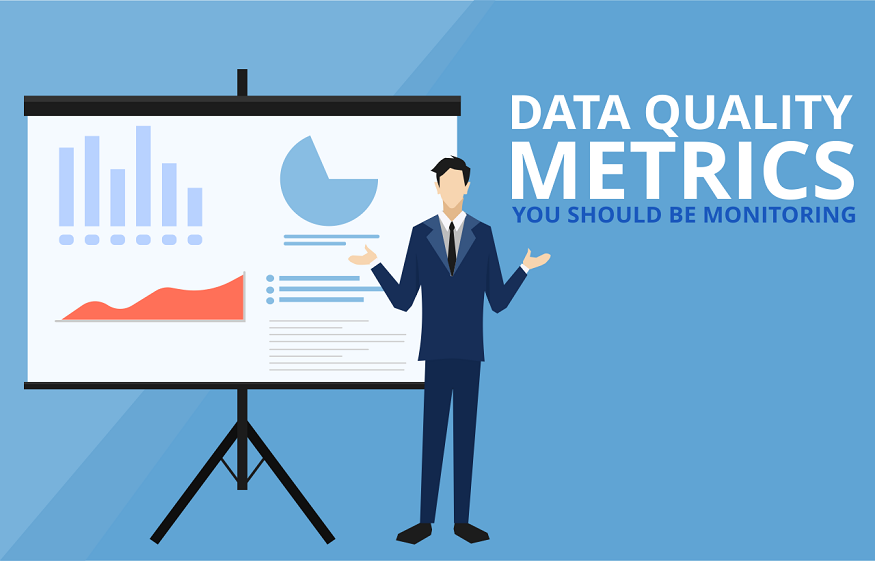As per a report, getting low-quality data may cost businesses around the world up to USD 15 million annually. And it can also affect the trust between the consumer base and the company.
That’s why taking care of your data quality is going to be important for you.
However, if you’re an owner of an SME, you probably might face a budgetary restraint or two while setting up a data metric system. So, let us tell you how you can take care of that.
Data Quality Metrics – What is It Really?
The term ‘data quality metric’ refers to a set of quantitative or qualitative measures used to assess the degree to which data meets certain criteria or standards.
These metrics are usually used to assess the accuracy, completeness, consistency, timeliness, and other aspects of data quality. Data quality metrics are important because they enable organizations to identify data quality issues and take corrective action.
And it can also be used to monitor and maintain the quality of data over time.
By measuring the quality of data, your organization can ensure that their information is fit for purpose and can be used effectively to support decision-making and analysis.
Common Data Quality Metrics
There are several data quality metrics available out there that can help your organization boost their efficiency massively.
- Accuracy: This metric measures how close the data is to the actual or true value. It can be usually performed by employing methods like cross-validation or comparison with an external reference. Maintaining accuracy will be important for making decisions.
- Completeness: This metric measures how much of the required data is available. It can be understood by using methods like missing value analysis or recording counts. With it, you’ll be able to find out more about how truthful the information actually is.
- Consistency: This metric is all about finding out how well the information conforms to predefined rules or expectations. You can measure the same by utilizing methods like duplicate detection or outlier analysis. Use the right tools to maintain consistency.
- Timeliness: This metric measures how current the data is. You will be able to find out this information by using methods, like data age analysis or comparison with external data sources. Nonetheless, you have to use a proper tool to find out more about it.
- Relevance: It is measured by using different tools and processes like data profiling or user feedback. It can also be performed through some manual steps. But that would be time-consuming
The Benefits of Using Data Quality Metrics
Using data quality metrics in a proper manner can be quite difficult at the first go. However, if you are capable of doing so, it might end up being highly beneficial for you.
Improved Decision-Making:
High-quality data is essential for making informed decisions. By using data quality metrics, organizations can identify and correct data quality issues, ensuring that the data is accurate, complete, and reliable. It leads to better decision-making and ultimately much better business outcomes. For example, if an organization is using inaccurate data to make decisions, they may make the wrong decisions, which can result in –
- lost revenue,
- decreased customer satisfaction, or
- increased costs.
By employing data quality metrics, companies can avoid these negative outcomes and make better decisions that positively impact their business.
Increased Efficiency:
Poor data quality can lead to wasted time and resources, as well as increased costs associated with rework and error correction. By using data quality metrics, organizations can identify and address data quality issues early on, which can increase efficiency and reduce costs.
For example, if an organization is using incomplete or inconsistent data, it may take longer to complete tasks, resulting in wasted time and increased costs.
By employing these metrics, organizations can identify these issues and take corrective action to increase efficiency and reduce costs.
Enhanced Customer Satisfaction:
High-quality data can improve customer satisfaction by ensuring that customer data is accurate, complete, and up-to-date. It can lead to better customer experiences and improved relationships with customers.
For example, if a customer’s contact information is inaccurate or incomplete, they may miss important communications from the organization that can negatively impact their satisfaction.
By using data quality metrics, organizations can ensure that customer data is accurate, complete, and up-to-date, resulting in improved customer satisfaction.
Compliance:
Data quality metrics can help organizations ensure compliance with regulations and standards related to data quality, such as the General Data Protection Regulation (GDPR) and the Sarbanes-Oxley Act. By using data quality metrics, organizations can ensure that their data is compliant with these regulations, which can help them avoid legal issues and penalties.
Improved Data Governance:
Data quality metrics are an important part of data governance, which is the overall management of data as an organizational asset. By measuring data quality, organizations can improve their data governance practices and ensure that data is managed effectively. This can help them avoid issues such as data breaches, data loss, or data misuse.
Better Insights:
Data quality metrics can help organizations identify trends and patterns in their data, which can lead to better insights and a deeper understanding of their business operations. For example, by analyzing data quality metrics, an organization may discover that certain data sources are consistently inaccurate, which can help them identify and correct the root cause of the issue.
Competitive Advantage:
Organizations that use data quality metrics to ensure high-quality data have a competitive advantage over those that do not.
They can make better decisions, provide better customer experiences, and operate more efficiently, which can lead to improved business outcomes and increased profitability.
For example, if an organization is using high-quality data to make decisions, they can identify and capitalize on opportunities faster than their competitors, giving them a competitive edge.

